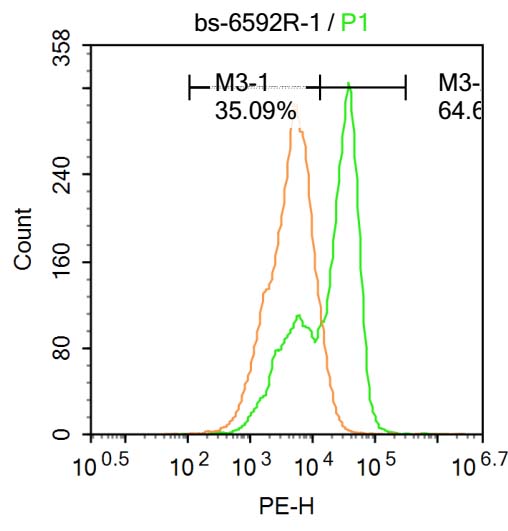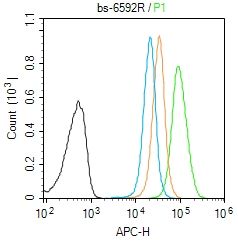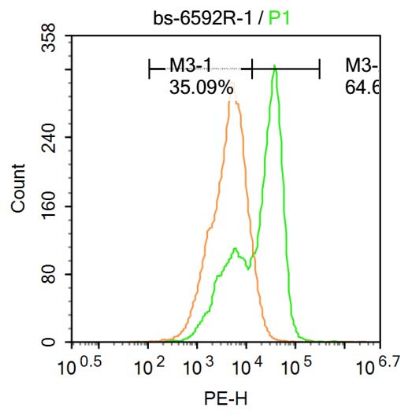HSD17B6 Rabbit pAb
HSD17B6 Rabbit pAb
- 产品详情
- 实验流程
- 背景知识
| Primary Accession | O14756 |
|---|---|
| Reactivity | Human |
| Predicted | Mouse, Rat, Pig, Horse |
| Host | Rabbit |
| Clonality | Polyclonal |
| Calculated MW | 35966 Da |
| Physical State | Liquid |
| Immunogen | KLH conjugated synthetic peptide derived from human HSD17B6 |
| Epitope Specificity | 61-160/317 |
| Isotype | IgG |
| Purity | affinity purified by Protein A |
| Buffer | 0.01M TBS (pH7.4) with 1% BSA, 0.02% Proclin300 and 50% Glycerol. |
| SUBCELLULAR LOCATION | Microsome membrane; Peripheral membrane protein; Lumenal side. Early endosome membrane; Peripheral membrane protein; Lumenal side (Potential). |
| SIMILARITY | Belongs to the short-chain dehydrogenases/reductases (SDR) family. |
| Important Note | This product as supplied is intended for research use only, not for use in human, therapeutic or diagnostic applications. |
| Background Descriptions | The protein encoded by this gene has both oxidoreductase and epimerase activities and is involved in androgen catabolism. The oxidoreductase activity can convert 3 alpha-adiol to dihydrotestosterone, while the epimerase activity can convert androsterone to epi-androsterone. Both reactions use NAD+ as the preferred cofactor. This gene is a member of the retinol dehydrogenase family. [provided by RefSeq, Aug 2013] |
| Gene ID | 8630 |
|---|---|
| Other Names | 17-beta-hydroxysteroid dehydrogenase type 6, 17-beta-HSD 6, 17-beta-HSD6, 1.1.1.105, 1.1.1.209, 1.1.1.239, 3-alpha->beta-hydroxysteroid epimerase, 3-alpha->beta-HSE, Oxidative 3-alpha hydroxysteroid dehydrogenase, Short chain dehydrogenase/reductase family 9C member 6, HSD17B6, RODH, SDR9C6 |
| Target/Specificity | Detected in liver and prostate (at protein level). Detected in adult liver, lung, brain, placenta, prostate, adrenal gland, testis, mammary gland, spleen, spinal cord and uterus. Detected in caudate nucleus, and at lower levels in amygdala, corpus callosum, hippocampus, substantia nigra and thalamus. Detected in fetal lung, liver and brain. |
| Dilution | Flow-Cyt=1ug/Test |
| Storage | Store at -20 °C for one year. Avoid repeated freeze/thaw cycles. When reconstituted in sterile pH 7.4 0.01M PBS or diluent of antibody the antibody is stable for at least two weeks at 2-4 °C. |
| Name | HSD17B6 |
|---|---|
| Synonyms | RODH, SDR9C6 |
| Function | NAD-dependent oxidoreductase with broad substrate specificity that shows both oxidative and reductive activity (in vitro). Has 17- beta-hydroxysteroid dehydrogenase activity towards various steroids (in vitro). Converts 5-alpha-androstan-3-alpha,17-beta-diol to androsterone and estradiol to estrone (in vitro). Has 3-alpha-hydroxysteroid dehydrogenase activity towards androsterone (in vitro). Has retinol dehydrogenase activity towards all-trans-retinol (in vitro). Can convert androsterone to epi-androsterone. Androsterone is first oxidized to 5-alpha-androstane-3,17-dione and then reduced to epi- andosterone. Can act on both C-19 and C-21 3-alpha-hydroxysteroids. |
| Cellular Location | Microsome membrane; Peripheral membrane protein; Lumenal side. Early endosome membrane; Peripheral membrane protein; Lumenal side |
| Tissue Location | Detected in liver and prostate (at protein level). Detected in adult liver, lung, brain, placenta, prostate, adrenal gland, testis, mammary gland, spleen, spinal cord and uterus. Detected in caudate nucleus, and at lower levels in amygdala, corpus callosum, hippocampus, substantia nigra and thalamus. Detected in fetal lung, liver and brain. |
For Research Use Only. Not For Use In Diagnostic Procedures.
Provided below are standard protocols that you may find useful for product applications.
BACKGROUND
The protein encoded by this gene has both oxidoreductase and epimerase activities and is involved in androgen catabolism. The oxidoreductase activity can convert 3 alpha-adiol to dihydrotestosterone, while the epimerase activity can convert androsterone to epi-androsterone. Both reactions use NAD+ as the preferred cofactor. This gene is a member of the retinol dehydrogenase family. [provided by RefSeq, Aug 2013]
终于等到您。ABCEPTA(百远生物)抗体产品。
点击下方“我要评价 ”按钮提交您的反馈信息,您的反馈和评价是我们最宝贵的财富之一,
我们将在1-3个工作日内处理您的反馈信息。
如有疑问,联系:0512-88856768 tech-china@abcepta.com.























 癌症的基本特征包括细胞增殖、血管生成、迁移、凋亡逃避机制和细胞永生等。找到癌症发生过程中这些通路的关键标记物和对应的抗体用于检测至关重要。
癌症的基本特征包括细胞增殖、血管生成、迁移、凋亡逃避机制和细胞永生等。找到癌症发生过程中这些通路的关键标记物和对应的抗体用于检测至关重要。 为您推荐一个泛素化位点预测神器——泛素化分析工具,可以为您的蛋白的泛素化位点作出预测和评分。
为您推荐一个泛素化位点预测神器——泛素化分析工具,可以为您的蛋白的泛素化位点作出预测和评分。 细胞自噬受体图形绘图工具为你的蛋白的细胞受体结合位点作出预测和评分,识别结合到自噬通路中的蛋白是非常重要的,便于让我们理解自噬在正常生理、病理过程中的作用,如发育、细胞分化、神经退化性疾病、压力条件下、感染和癌症。
细胞自噬受体图形绘图工具为你的蛋白的细胞受体结合位点作出预测和评分,识别结合到自噬通路中的蛋白是非常重要的,便于让我们理解自噬在正常生理、病理过程中的作用,如发育、细胞分化、神经退化性疾病、压力条件下、感染和癌症。








